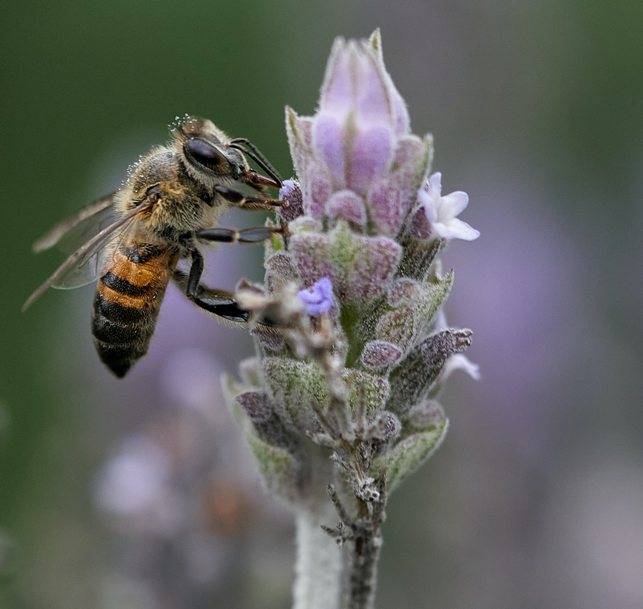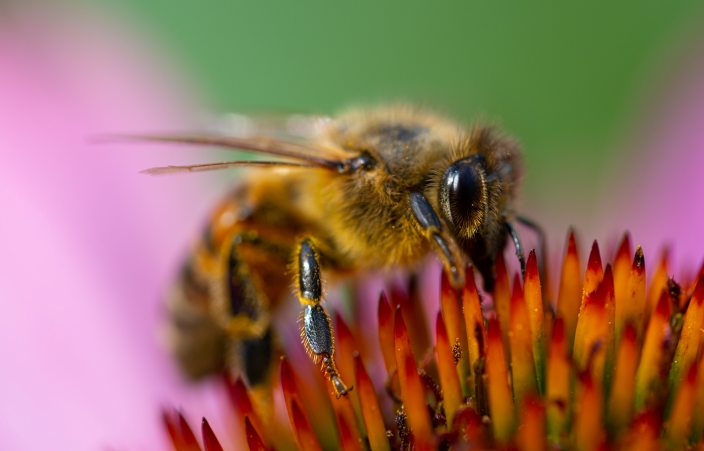When I say the word “wings,” I guarantee that everyone here thinks it’s a set of two. After all, birds have two wings, so it would be natural to assume that bees do so too.
In reality, though, several insects have two pairs of wings, and bees are no different. In this article, we’ll be talking about the anatomy of a bee, specifically about its legs and wings.
Right off the bat, bees have three sets of legs (i.e., 6 legs) and two sets of wings (i.e., 4 wings). Interestingly, a bee’s front pair of wings are much, much larger than the rear pair.
That’s pretty much it, but if you want to learn more about a bee’s body and how it is single handedly saving the world, read on.

Image source leandro fregoni on Unsplash
Why Is This Even An Article?
Yes, I get you: indeed lots of other insects have six legs and four wings; what is so special about that? Quite a lot actually.
A bee’s legs aren’t quite the same as most other insects. For instance, most of the other insects and anthropods use their legs for walking and locomotion.
Bees, on the other hand, need their wings not only for walking but also for flying, personal hygiene, and species propagation.
How? You’ll find out in a bit.
As for why are the wings essential, I will try to highlight how bees have adapted to their lifestyle by developing a size difference between the two pairs of wings that they have.
Quite brilliant in my opinion. We, as humans, haven’t even been able to get rid of our wisdom teeth.
I think it would be better if we do this in a question and answer format, and also stick around till the end — I’ve got some really interesting questions answered in this piece.
How many wings does a bee have?
A bee has a total of four wings, two very large ones the same length as the abdomen, and two smaller ones right below the large ones.
These wings play a significant part in the bees’ lives, not just for flying but also to ventilate the hive.
The airflow caused by the wings helps reduce the moisture content in the hive, which in turn speeds up the process of honey production.
That is why you’ll see bees “vibrating” their wings when on the ground or near their hive; they do this to ventilate the space around their bodies.
Fun fact: bees’ wings are also the reason they got part of their scientific name: they are part of the “Hymenoptera” order.
Translated, the word is Hymen (Membrane) and Petra (wings), and bees do indeed have “membrane wings”.
The membrane in question is made up of a substance called chitin, which also makes up the bee’s body wall.
Thus it can be said that the wings of a bee are actually a part of its skeleton!
Lastly, a rather vexing question is do bees have 2 or 4 wings? Scientists debate whether bees have two pairs of wings or one pair of wings divided into two.
This is because when in flight, the smaller wings attach to the bigger pair with hooks (called humuli) to assist in flying, so technically a bee has only two wings while in flight.
How many legs does a bee have?
First off, I’ve often seen people asking beekeepers “How many legs does a queen bee have?” or “How many legs does a bumblebee have?”
Let me start by saying that all bees have six legs, although the purpose of those legs is entirely different, depending on the type of bee.
Each bee has three sets of legs, one on each of the three segments of its body.
The front pair of legs is for personal hygiene; yes you read that right. Bees are some of the cleanest creatures on the planet, just like ants.
They use their front legs to groom their antennae and in some species, to taste whether or not the nectar of a flower is any good. They do this via special taste receptors on the forelegs.
A bee also uses its forelegs to manipulate and maneuver pollen from flowers onto its hind legs. Why on the hind legs do you ask?
Well, bees collect and transport pollen from flower to flower by “storing” the pollen on their hind legs.
This is done with the help of pollen baskets (called corbicula) or through a mass of hair on the legs (called scopa).
Not all bees have pollen baskets; those are only present in species like the bumblebee and honeybee. You’ll find a scopa on bees like the mason bee and leafcutter bee.
How fast do a bee’s wings flap?
They don’t. A “flap” is a different type of movement to a “beat”, which is what a bee does.
To answer the question, there are numerous answers, but most fall into the 180-260 beats per second (not abbreviated as BPS) category.
That’s even faster than some species of hummingbird.
Fact: unlike aeroplanes, a bee flies better with its “landing gear” down.
What I mean by that is bees find it easier to fly with their legs down as opposed to tucking them underneath themselves.
This is because the “dangling” of the legs (especially the hind legs) helps to produce lift forces, much like the wings of a plane.
How do bees fly in the first place? Their wings are so small.
See the thing is that bees use a mix of techniques to help them “fly”.
I put in those quotations because people argue (a lot) as to whether bees, like hummingbirds, fly or hover.
When in flight, a bee uses three techniques to achieve the ratio of more lift than drag. These are:
- A very rapid wing beat frequency rate (~220 beats per second),
- Short, choppy, almost “laggy” wing strokes, and
- A quick, precise, rotation of the wing as it moves backwards.
Any single factor alone will not enable the bee to get off the ground, but when used in conjunction with one another, the bee “flies”.
Another thing scientists have not been able to ascertain is whether or not a bee can move its wings independently of each other — that remains to be seen.

Image source: Kris-Mikael Krister on Unsplash
How do bees flap their wings so fast anyway?
A bee uses specially developed muscles inside its thorax to power its wings.
Because there are two sets of wings, there are also two sets of muscles inside a bees thorax that enable fight,
One pair of muscles is laid out vertically, and the other is horizontal. When the horizontal muscles contract, the thorax increases in size producing an “up” motion.
The vertical muscles work vice-versa: when they contract, the thorax shortens producing a “down” movement of the wings.
Both pairs of wings are powered by these muscles.
This motion is repeated over and over again to produce flight in a bee, and additionally, when a bee moves its wings “down”, there is a slight backward rotation of the entire wing set to facilitate better lift for the bee.
What’s so special then?
The anatomy of a bee has an almost perfect efficiency. Each body part of a bee is tuned like a car to better serve the roles of each individual type of bee (worker, drone, and queen).
This has, of course, come from millions of years of evolution, but there is some bad news.
Bees are responsible for pollination on a very large scale, but sadly, due to human activity, they are going extinct at a very rapid pace.
Put simply, we cannot survive without bees (there are other pollinators, but none work on the scale that bees do).
That is why I’d request you to get rid of bees in a non-lethal way if you happen to find any in your house because, every little bit counts towards saving their population, and by extension, ours.
Read here: